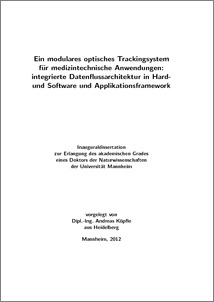|
Ein modulares optisches Trackingsystem für medizintechnische Anwendungen: integrierte Datenflussarchitektur in Hard- und Software und Applikationsframework
Köpfle, Andreas
![[img]](https://madoc.bib.uni-mannheim.de/style/images/fileicons/application_pdf.png)  Vorschau |
|
PDF
Diss_AKoepfle_Publication.pdf
- Veröffentlichte Version
Download (16MB)
|
|
URL:
|
https://ub-madoc.bib.uni-mannheim.de/34781
|
|
URN:
|
urn:nbn:de:bsz:180-madoc-347817
|
|
Dokumenttyp:
|
Dissertation
|
|
Erscheinungsjahr:
|
2012
|
|
Ort der Veröffentlichung:
|
Mannheim
|
|
Verlag:
|
Universität Mannheim
|
|
Hochschule:
|
Universität Mannheim
|
|
Gutachter:
|
Männer, Reinhard
|
|
Datum der mündl. Prüfung:
|
11 Februar 2013
|
|
Sprache der Veröffentlichung:
|
Deutsch
|
|
Einrichtung:
|
Fakultät für Wirtschaftsinformatik und Wirtschaftsmathematik > Informatik V (Männer 1992-2008)
|
|
Fachgebiet:
|
004 Informatik
|
|
Normierte Schlagwörter (SWD):
|
Medizinische Informatik , Maschinelles Sehen , Optische Messtechnik , Mehrkamerasystem , Objektverfolgung
|
|
Freie Schlagwörter (Englisch):
|
optical tracking system , training simulator , hardware/software architecture , dataflow architecture
|
|
Abstract:
|
Die vorliegende Arbeit beschreibt die Entwicklung eines modularen optischen
Trackingsystems, ausgerichtet auf die speziellen Anforderungen im
medizintechnischen Umfeld. Das Spektrum der vorgestellten Anwendungen des Systems reicht dabei von der Erfassung der Benutzerinteraktion in verschiedenen medizinischen Simulatoren (z.B. für Ophthalmochirurgie, Ophthalmoskopie und Neurochirurgie) bis hin zur Positionserfassung eines handgehaltenen Operationsroboters. Im Unterschied zu verfügbaren kommerziellen Trackingsystemem mit ihren eng umrissenen Anwendungsbereichen wird ein universell ausgelegtes Baukastensystem vorgestellt, das sich mit geringem Entwicklungsaufwand an die speziellen Anforderungen der jeweiligen Anwendungen anpassen lässt (so u.a. sehr kleine Geometrien, deformierbare Objekte, Einsatz von Originalinstrumenten, geringe Ressourcenverfügbarkeit im Simulator-PC). Zu diesem Zweck wird ein modulares Systemkonzept
entwickelt, welches von der spezialisierten Datenverarbeitung gängiger
Trackingsysteme abstrahiert und auf einer generalisierten, modularen Systemarchitektur für den Einsatz aller Arten von Markern mit drei
Freiheitsgraden aufbaut. Neben den verbreiteten infrarotbasierten Signaliserungstechniken werden dabei auch passive Farbmarker zur
Objektsignalisierung unterstützt. Die Implementierung von Bildverarbeitungsaufgaben in spezialisierter Hardware (FPGAs) direkt auf
dem Kameradatenstrom ermöglicht eine frühzeitige Datenreduktion und damit niedrige Latenzzeiten. Der Entwicklungsprozess für neuartige Trackinglösungen wird vereinfacht durch die enge Integration der Hard- und
Softwaremodule in einer einheitlichen durchgängigen Datenflussarchitektur,
die flexibel an die jeweilige Aufgabenstellung anpassbar ist. Ein erweiterbares graphisches Frontend schließlich unterstützt bei Betrieb und
Konfiguration und erlaubt auch die Simulation ganzer Systeme während der Entwicklung.
|
|
Übersetzter Titel:
|
A modular optical tracking system for medical engineering applications:
integrated dataflow architecture in hard- and software and application
framework.
(Englisch)
|
|
Übersetzung des Abstracts:
|
This thesis describes the development of a modular optical tracking system,
aimed at the special requirements in the field of biomedical engineering.
The system's presented applications range from capturing user interaction
in different medical simulators (e.g. for ophthalmic surgery, opthalmoscopy
and neurosurgery) to pose acquisition of a handheld surgical robot. In
contrast to available commercial tracking systems with their closely
defined scope a universal system architecture is introduced, which may be
easily adopted to specific requirements of medical applications (such as
very small geometries, deformable objects, use of genuine surgical
instruments, low resource availability in the simulator's PC). This modular
concept abstracts from the specialized data processing of conventional
tracking systems and is based on a generalized modular system architecture
supporting the use of all types of beacons with 3 degrees of freedom. Apart
from commonly used infrared beacons, colorized passive marker objects are
supported as well. By implementing the image processing in specialized
hardware (FPGAs) directly on the camera data stream, data can be reduced at
an early stage, which leads to low latency times.
The close integration of hard- and software modules into a uniform data
flow architecture simplifies the development of new tracking solutions,
thus facilitating flexible adaption to the specific tracking tasks. Finally
an extensible graphical frontend aids with control and configuration and
supports simulation of entire systems during development.
(Englisch)
|
 | Dieser Eintrag ist Teil der Universitätsbibliographie. |
 | Das Dokument wird vom Publikationsserver der Universitätsbibliothek Mannheim bereitgestellt. |
 Suche Autoren in Suche Autoren in
Sie haben einen Fehler gefunden? Teilen Sie uns Ihren Korrekturwunsch bitte hier mit: E-Mail
Actions (login required)
 |
Eintrag anzeigen |
|
|
